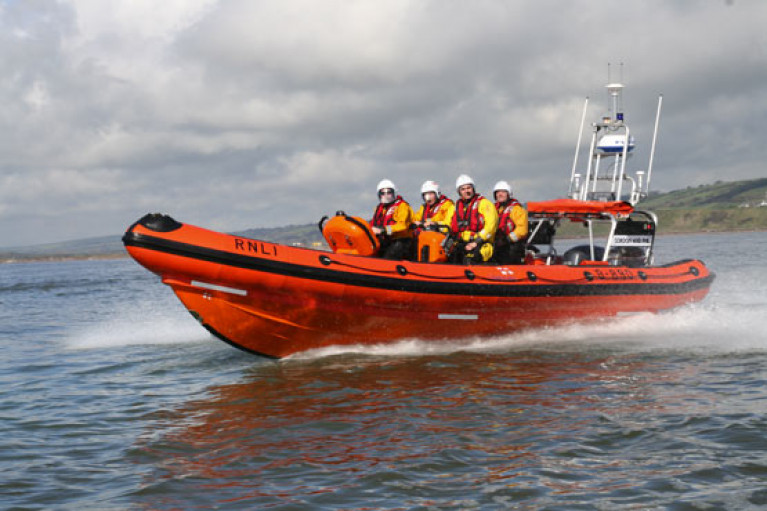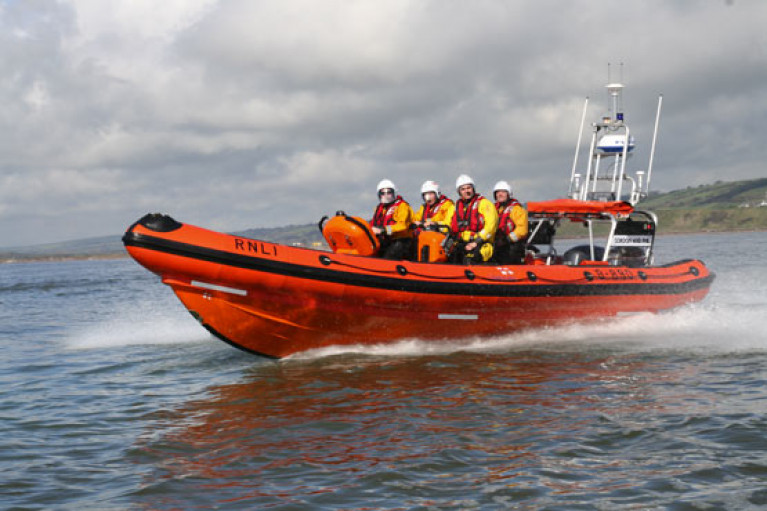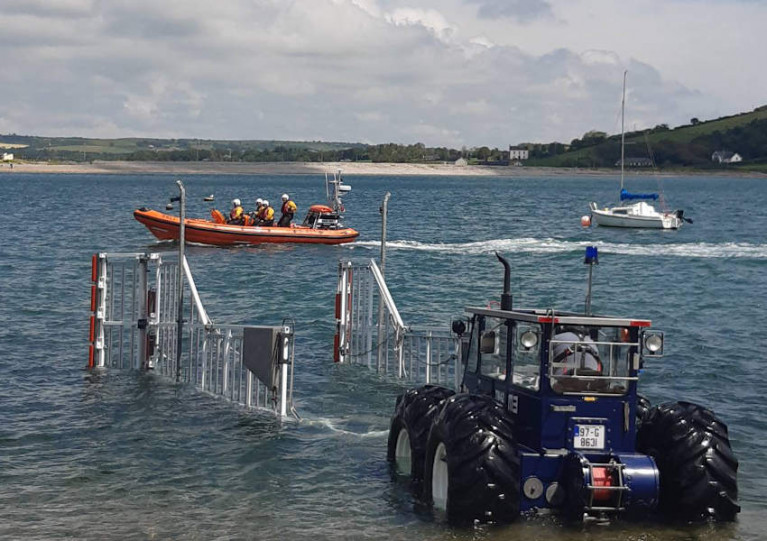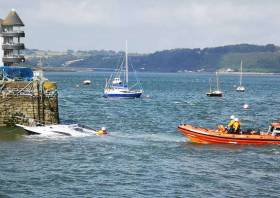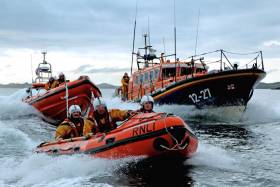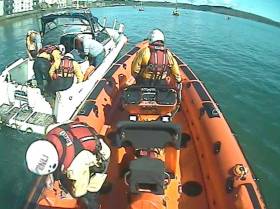Displaying items by tag: youghal
A woman was evacuated for medical attention by Youghal RNLI yesterday evening (Monday 10 August) after she slipped and fell on rocks below the East Cork harbour’s lighthouse.
The volunteer lifeboat launched at 5.07pm in perfect sea conditions and on a falling tide, reaching the casualty in just three minutes.
Two crew members went ashore with a stretcher to assist the fire brigade and Irish Coast Guard crews who were already at the scene.
Following the Government and RNLI guidelines concerning Covid-19, the casualty was placed onto the stretcher and transferred to the lifeboat.
She was then taken to Youghal lifeboat station where an ambulance was waiting to bring her to Cork University Hospital.
Speaking after the callout, Youghal RNLI’s deputy launching authority Mark Nolan said: “We would like to wish today’s casualty a speedy recovery.
“It can be very easy to fall and slip whilst out walking — be wary of all edges around the sea and water, and always take a means of calling for help with you.”
This year follows one of the busiest for Youghal RNLI in its 180-year history, with a record number of callouts. And 2020 has been especially challenging time for everyone thus far.
As a charity that relies 100% on public donations for its funding, the RNLI have definitely felt the effects of fundraising events being cancelled, bucket collections unable to go ahead and RNLI shops being closed.
If you can make a donation to Youghal RNLI or your local lifeboat at this time, it would be greatly appreciated.
Youghal Lifeboat Launches To Fishing Boat With Engine Trouble
Youghal RNLI’s volunteer crew were paged this morning (Sunday 2 August) at 8.03am to help a one-person fishing boat with engine trouble, six miles south of Capel Island off East Cork.
Operating safely within the RNLI and Government Covid-19 guidelines, the inshore lifeboat crew reached the 16ft fishing boat shortly after launch in good weather conditions.
One member of the crew boarded the fishing boat and, after making sure that the person on board was fine, a tow was established to bring the vessel back to Ferrypoint.
Speaking after the callout, deputy launching authority Mark Nolan said: “Engine trouble is one of the main reasons for RNLI callouts. Problems can occur at any time; being prepared is key.
“Always carry a form of communication with you, just like the person on-board today; once he realised there was a problem, he was able to call for help straight away, avoiding any unnecessary danger.”
Youghal RNLI’s inshore lifeboat and her volunteer crew responded to their pagers yesterday (Sunday 14 June) when the alarm was raised by two people aboard a fishing vessel with steering failure.
Helmed by Liam Keogh, The lifeboat launched just before 1pm to the 20ft fishing vessel, 2km south east of Youghal Harbour near the Black Ball buoy, in fairly calm sea conditions.
Once the fishing boat was located, one crew member boarded, following all Covid-19 guidelines and procedures, and worked to quickly establish a tow.
The fishing vessel was then safely towed back to its mooring in Ferrypoint and the lifeboat returned to the station by 1.40pm.
Speaking after the callout, Lou Stepney, Youghal RNLI’s volunteer press officer, said: “Mechanical failure is one of the main reasons for RNLI callouts.
“Situations can change very quickly at sea. We advise anyone out on the water to be prepared for an emergency by always wearing a lifejacket, checking your equipment before you set off and always to carry a means of calling for help, call 112/999 and ask for the coastguard.”
Youghal Lifeboat Tasked In Search For Missing Person
Youghal RNLI’s volunteer crew were part of a multi-agency operation yesterday evening (Sunday 24 May) to reports of a missing person in Youghal.
The inshore lifeboat launched in good weather on a filling tide at 6.04pm a few minutes after pagers sounded.
Working alongside the Irish Coast Guard and its Rescue 117 helicopter from Waterford, a comprehensive search was undertaken from the inner harbour at Youghal to Knockadoon.
But the lifeboat crew were pleased to stand down at 7.30pm after the reported person was found safe on shore.
Speaking following the callout, Youghal RNLI lifeboat operations manager Derry Walsh said: “We welcome the news that the individual was found safe and well.
“We would like to remind the public that although our volunteers are currently not taking part in weekly training exercises due to the Covid-19 pandemic, we remain on call and available 24/7.
“If in need of help please call 112/999 and ask for the coastguard.”
The Youghal lifeboat crew on this callout were Martin Morris, Mike Brooks, Jack Nolan and Karen Walsh.
Youghal RNLI Assist Fishing Boat Aground at Ferry Point in Stormy Conditions
The volunteer crew of Youghal RNLI were paged yesterday at 4.57 pm to reports of a fishing vessel with one person onboard aground on the rocks at the northern end of Ferry Point.
Launching in force 8 North Westerly winds and choppy conditions, the inshore lifeboat arrived on the scene a few minutes later to find the fisherman had managed to get safely onto land.
The crew established a tow line and brought the fishing boat off the rocks and alongside the lifeboat. One crew member then boarded the vessel and began to pump out water as it was towed safely back to Harvey’s dock and handed over to the awaiting Coast Guard unit.
The Lifeboat returned to the station at 5.41 pm. The Lifeboat crew were, Patsy O’Mahoney (Helm), James Hanna, Liam Keogh and Jack Nolan.
Patsy O’Mahoney, Youghal RNLI Helm said: ‘Situations can change very quickly at sea, especially in stormy conditions. Our training really stood to us today dealing with the swell and high winds’.
Retiring Youghal RNLI Volunteer Recognised For 30 Years Of Service
The volunteers of Youghal RNLI recently gathered at Berties bar in the East Cork town to mark the retirement of long-serving crew member John Innes.
John first became involved in 1987 and was fully enrolled as a crew member by 1988. He went on to become a helm on three Atlantic class lifeboats: the Atlantic 21 Marjory Turner, Atlantic 75 Patricia Jennings and the current Atlantic 85 Gordon and Phil.
He also served as lifeboat training co-ordinator between 2001-2009 and again between 2016-2017.
Speaking on the night, John said: “Since I started with the RNLI 30 years ago, I’ve seen many changes and big improvements, the standard of training is so high these days.”
There have been many memorable rescues for John over the years. One he remembers from his early days happened one summer evening, when a man from Cork city traveled to Youghal to try out his new surfboard that he’d received as a birthday gift.
John recalls: “The man had booked a surfing lesson, but the teacher was late so he decided to go out on his own. Shortly after he entered the water, he began to be swept out to sea with the offshore breeze.
“When we arrived the man was in the water and being carried further out to sea, he was freezing cold. Had we not arrived when we did, the outcome could have been very different.”
During his 30 years with Youghal RNLI, John Innes was instrumental in saving 34 lives at sea.
Deputy launching authority Brendan O’Driscoll said: “The time, effort and commitment John has shown to Youghal RNLI over the last 30 years has been outstanding.
“On behalf of everybody at the lifeboat station, I would like to thank him for the immense contribution he has made over the years and we all wish him well in his future endeavours.”
Youghal Lifeboat Called To Vessel Sinking In Harbour
A boat sinking on its moorings at Youghal Harbour in East Cork prompted a callout for the local RNLI volunteers yesterday afternoon (Friday 20 September).
Only the bow of the 24ft boat was visible when the lifeboat crew arrived. A towline was set up and the vessel was brought as close to the pier as possible on the falling tide.
With assistance from the local coastguard unit, the boat was secured with two rides for the owner to attend too at low tide, Youghal RNLI reports.
Crosshaven Lifeboat Assists Yacht With ‘Smoke In Engine Bay’
Crosshaven RNLI has came to the aid of a sailor after his yacht got into difficulty off Cork Head on Friday (21 June).
The UK-registered yacht en route from Kinsale to Crosshaven broadcast a PAN PAN alert after its skipper spotted smoke in his engine bay.
Crosshaven’s crew of Warren Forbes, Denis Cronin, Aidan O’Connor and Derek Moynan were paged at 4.13pm and launched their inshore lifeboat to the reported position.
Once on scene, they assessed that there was no fire in the engine bay, but that the engine was disabled.
The casualty vessel was then towed to Crosshaven boatyard and safely berthed.
Crosshaven RNLI helm Warren Forbes said: “A fire onboard a vessel is a sailor's worst nightmare but fortunately no fire was observed when we arrived on scene.
“The yachtsman made the correct decision by not opening the engine bay and calling for help.”
More recently in Cork, Youghal RNLI launched in poor weather conditions yesterday (Sunday 23 June) to reports of a swimmer in trouble some 500m off Claycastle.
Fortunately the swimmer managed to get to safely back to shore as the inshore lifeboat arrived at the scene.
New Clifden Lifeboat Volunteer Put To The Test In Callout To Fishing Vessel With Engine Failure
New Clifden lifeboat volunteer Ashling Sweeney has her first callout earlier this week to a fisherman whose boat drifted out to sea after engine failure.
At 3.40pm on Tuesday 4 June, Clifden RNLI was requested to launch its all-weather and inshore lifeboats to assist the nine-metre fishing vessel with one onboard just east of Turbot Island in Co Galway.
Clifden’s Atlantic 85 lifeboat Joyce King, helmed by Daniel Whelan and with four volunteer crew onboard, launched first and made good time to the fishing vessel, which was drifting south.
The fishing vessel was quickly taken under tow back to Clifden pier as Clifden RNLI’s all-weather lifeboat launched to provide backup.
Weather conditions on scene had a north-west winds of Force 5-6 with a slight sea.
Speaking following the callout, new volunteer Ashling Sweeney said: “This was my first callout for Clifden RNLI today and I was happy to gain the experience of putting my training into action.”
Around the same time on Tuesday, Youghal RNLI in East Cork were requested to launch to an eight-metre yacht adrift in the harbour with no people onboard.
The volunteer crew launched their inshore lifeboat in a moderate north westerly breeze and were with the yacht within minutes.
On arrival, the crew determined that the yacht was dragging its mooring. A crew member boarded the yacht and cut the mooring line before the crew established a tow and bought the yacht safely back to the pontoon were the coastguard were waiting to assist.
Derry Walsh, Youghal RNLI lifeboat operations manager, said: “As we approach the summer season, we would remind sailors and boat owners to ensure the appropriate safety, engine and fuel checks are completed ahead of any trip as well as ensuring vessels are safely secured on their moorings.”
Youghal RNLI launched to the aid of two people whose moored yacht was taking on water yesterday morning (Monday 20 May).
The volunteer lifeboat crew was requested to launch by the Irish Coast Guard at 10.01am following a report that a 26ft leisure craft was taking on water.
hHelmed by Liam Keogh, the inshore lifeboat was on scene within minutes, in clear conditions.
The casualty boat was tied up at its moorings in Youghal Harbour, with the two people onboard trying to pump the water out with a hand pump.
Two lifeboat crew boarded the vessel with a salvage pump and made sure the people onboard were well. They then used the salvage pump to pump the water out.
The lifeboat crew requested the coastguard for quayside assistance and towed the leisure craft safely back to the slip where it was taken ashore on a trailer.
Speaking later, Youghal RNLI helm Liam Keogh said: “This was a smooth callout for the crew and we were delighted to be able to help.”


























